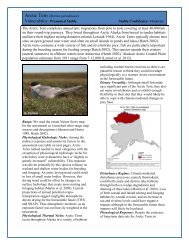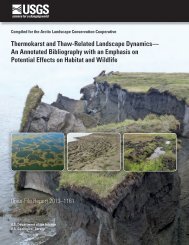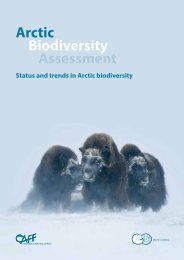Assessing Climate Change Vulnerability of Breeding Birds in Arctic ...
Assessing Climate Change Vulnerability of Breeding Birds in Arctic ...
Assessing Climate Change Vulnerability of Breeding Birds in Arctic ...
You also want an ePaper? Increase the reach of your titles
YUMPU automatically turns print PDFs into web optimized ePapers that Google loves.
AdTundra Swan (Cygnus columbianus)<strong>Vulnerability</strong>: Presumed StableConfidence: HighThe Tundra Swan is the more widespread and northerly rang<strong>in</strong>g <strong>of</strong> the two native swan species<strong>in</strong> North America. In <strong>Arctic</strong> Alaska, they nest <strong>in</strong> wet to dry tundra habitat types preferr<strong>in</strong>g islands<strong>in</strong> lakes or ponds, or naturally occurr<strong>in</strong>g frost heaves at the <strong>in</strong>tersection <strong>of</strong> polygon pond rims.Nest<strong>in</strong>g territories almost always <strong>in</strong>clude a large lake that the family will use as a safe havenfrom terrestrial predators (Limpert and Earnst 1994). Dur<strong>in</strong>g the breed<strong>in</strong>g season, their diet isprimarily vegetarian, eat<strong>in</strong>g emergent and submerged vegetation <strong>in</strong> lakes and ponds. They alsograze on terrestrial vegetation near the water (Limpert and Earnst 1994). Most North Slopebreeders w<strong>in</strong>ter on the east coast Mid-Atlantic States (Limpert and Earnst 1994). The current<strong>Arctic</strong> Coastal Pla<strong>in</strong> population is estimated at approximately 10,000 (Larned et al. 2012).E. WeiserRange: We used the extant NatureServe rangemap for the assessment as it closely matched the<strong>Birds</strong> <strong>of</strong> North America and other rangedescriptions (Johnson and Herter 1989, Bart etal. 2012).Human Response to CC: Human activities <strong>in</strong>response to climate change, <strong>in</strong> particular,shorel<strong>in</strong>e fortification aga<strong>in</strong>st erosion couldimpact Tundra Swans as they sometimes usenear coastal areas for rest<strong>in</strong>g and forag<strong>in</strong>g dur<strong>in</strong>gmigratory stag<strong>in</strong>g (Limpert and Earnst 1994).However, such activity will likely be localized<strong>in</strong> the near future so it was considered to slightly<strong>in</strong>crease vulnerability, if at all.Physiological Hydro Niche: Tundra Swans wereranked as particularly vulnerable to changes <strong>in</strong>hydrologic niche because <strong>of</strong> their dependence onlakes for breed<strong>in</strong>g and molt<strong>in</strong>g (to avoidpredation) and aquatic vegetation (for forag<strong>in</strong>g).Non-breed<strong>in</strong>g flocks also rely heavily on lakes.If substantial dry<strong>in</strong>g occurs, this species couldexperience a considerable negative impact.Current projections <strong>of</strong> annual potential evapotranspirationsuggest negligible atmosphericdrivendry<strong>in</strong>g for the foreseeable future (TWSand SNAP), and atmospheric moisture, as anexposure factor (most <strong>in</strong>fluential on the“hydrological niche” sensitivity category), wasnot heavily weighted <strong>in</strong> the assessment.However, its <strong>in</strong>teraction with hydrologicprocesses is very poorly understood (Mart<strong>in</strong> etal. 2009).Disturbance Regime: <strong>Climate</strong>-mediateddisturbance events, namely thermokarst, couldboth create and destroy good forag<strong>in</strong>g andnest<strong>in</strong>g habitats through both ice wedgedegradation and dra<strong>in</strong><strong>in</strong>g <strong>of</strong> thaw lakes (Mart<strong>in</strong>et al. 2009). Likewise, predicted <strong>in</strong>creased stormfrequency (Jones et al. 2009) could reduceavailability <strong>of</strong> their primary forage(submerged/emergent vegetation) as waterturbulence <strong>in</strong> bays and rivers could <strong>in</strong>crease (S.Earnst, pers. comm.).Biotic Habitat Dependence: Tundra Swansdepend on Arctophila grass for brood-rear<strong>in</strong>gcover thus the “biotic habitat dependencecategory” was considered a source <strong>of</strong>vulnerability. The broad range <strong>of</strong> responses <strong>in</strong>this category (from “neutral” to “greatly<strong>in</strong>creased” vulnerability) reflects the uncerta<strong>in</strong>ty40








